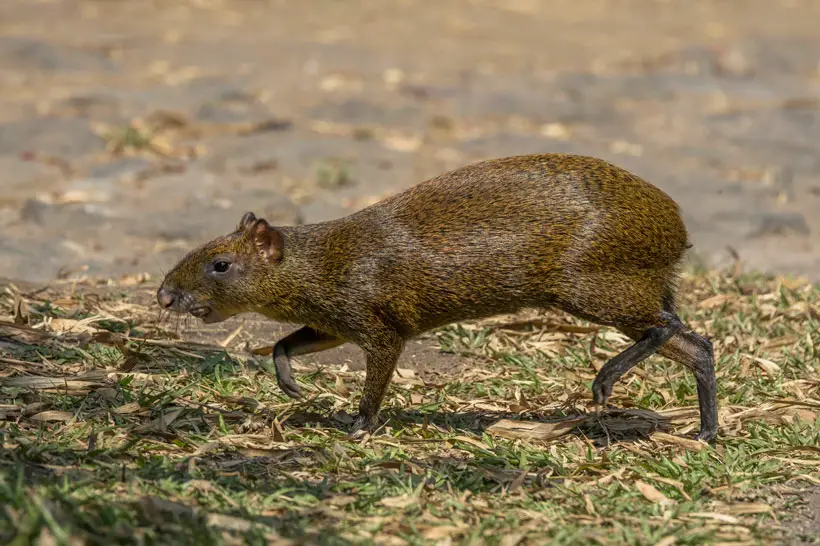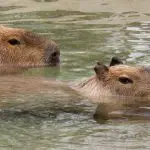Agouti vs. Capybara: How Do These South American Rodents Differ?
South America is home to many species, including some of the most fascinating rodents on the planet. Agouti and capybara are two such rodents that have captured the attention of many people. Although both rodents share a common geographical location, they are vastly different.
So, what are the key differences between Agouti vs. Capybara? Agouti is smaller and has a more slender body shape with a short tail. It’s most active during the day and has a monogamous mating behavior. On the other hand, the capybara is larger, with a stockier body and a vestigial tail. It’s crepuscular and diurnal and has a polygamous mating system.
Continue reading to learn more about the unique differences between these South American rodents.
Scientific Classification of Agouti and Capybara
Before diving into the differences between agouti and capybara, it is essential to understand their scientific classification. Both rodents belong to the order Rodentia, the largest group of mammals.
Scientific Classification of Agouti

Here is the scientific classification of Agouti.
- Kingdom: Animalia
- Phylum: Chordata
- Class: Mammalia
- Order: Rodentia
- Family: Dasyproctidae
- Genus: Dasyprocta
- Species:
- Dasyprocta coibae– Coiban agouti
- Dasyprocta punctata– Spotted paca
- Dasyprocta azarae– Azara’s agouti
- Dasyprocta cristata– Crested agouti
- Dasyprocta fuliginosa– Black agouti
- Dasyprocta ruatanica– Ruatan Island agouti
- Dasyprocta mexicana– Mexican agouti
- Dasyprocta leporina– Orange-rumped agouti
- Dasyprocta guamara– Orinoco agouti
- Dasyprocta punctata– Central American agouti
- Dasyprocta leporina– Red-rumped agouti
Scientific Classification of Capybara

Here is the scientific classification of Capybara:
- Kingdom: Animalia
- Phylum: Chordata
- Class: Mammalia
- Order: Rodentia
- Family: Hydrochoeridae
- Genus: Hydrochoerus
- Species: Hydrochaeris
Overview of Key Differences Between Agouti vs. Capybara
To help summarize the differences between agouti and capybara, here is a table below that outlines their fundamental differences.

| Categories | Agouti | Capybara |
|---|---|---|
| Geographic Range | Mexico to Brazil and parts of the Caribbean | Brazil, Argentina, Venezuela, Colombia, and Uruguay |
| Habitat | Rainforests, savannas, grasslands, and mountainous regions | Grasslands, forests, swamps, and marshy areas |
| Size | 16-30 inches long and weighs up to 13 lbs | 3.5 feet to 4 feet long and weighs up to 140 lbs |
| Fur Color | Black, red-brown, or brown | Brownish-gray or yellowish-brown |
| Body Shape | Slim and slender | Large and stocky |
| Tail | Short and hairless | Vestigial (barely visible) |
| Feet | Three toes on the hind feet and four on the front feet | Three toes on the front and four on the rear |
| Social Behavior | Solitary or live in pairs | Live in large groups |
| Activity Pattern | Diurnal | Diurnal or crepuscular |
| Diet | Primarily herbivorous, eats seeds, nuts, fruits, and insects | Herbivorous, eats grass and aquatic plants |
| Predator Defense | Aggressive defenders | Enter water bodies and stay submerged |
| Mating Behavior | Males spray females with urine to signal readiness to mate | Males compete for females through dominance |
| Mating Season | December to April | September to December |
| Reproduction and Parental Care | Females give birth to 1 to 4 young | Females give birth to 1 to 7 young |
| Lifespan | 8-15 years in the wild and upto 20 years in captivity | Up to 8-10 years and upto 12 years in captivity. |
Agouti vs. Capybara: Physical Differences
Agouti and capybara have several physical differences, making it easy to distinguish between them. Here are some key physical differences between them.
Fur Color
The agouti’s fur has a range of colors, including red-brown, black, or brown, while the capybara’s fur is typically brownish-gray. Agouti fur may also have a speckled or spotted pattern, while capybara fur is generally uniform in color. Their coat is also sparser and shorter than agouti’s fur.
Size
Capybaras are the largest rodents in the world, with an average length of around 4 feet and a weight of 77-146 pounds. Agouti, on the other hand, is much smaller, with an average size of about 16-30 inches and a weight of around 4.4-13.2 pounds.

Body Shape
Agoutis have a more slender and elongated body shape than capybaras, which have a more robust and barrel-shaped body. Additionally, agoutis have longer hind legs and shorter front legs, while capybaras have roughly equal leg lengths.

Tail Type
Agoutis have a short tail, typically only a few inches in length, that is hairless, while capybaras have a vestigial tail that is barely visible.
Feet
Agouti and capybara also have different foot structures. Agoutis have four toes on their front feet and three on their back feet. In contrast, capybara has three toes on their front feet and four on their rear feet.
This difference is believed to be an adaptation for the capybara to be better suited for swimming and walking on wetlands.
Agouti vs. Capybara: Behavioral Differences
Agoutis and Capybara have several behavioral differences, making studying them enjoyable. Here are some critical behavioral differences between these rodents.
Social Behavior
Agoutis are highly territorial solitary animals and can become quite aggressive toward intruders. They use scent marking and vocalization to defend their territory.
In contrast, capybaras are highly social animals and live in large groups of up to 20 individuals. They are peaceful, and their social structure is highly cooperative.

Activity Patterns
Agoutis are primarily active during the day, while capybaras are crepuscular, meaning they are most active at dawn and dusk and are also diurnal. Capybaras are known to be excellent swimmers and spend a considerable amount of time in the water, while agouti prefers to stay on land.
Diet Habit
Agoutis and capybaras have different dietary requirements. Agouti are primarily herbivores and feed on fruits, nuts, seeds, and other plant materials. They occasionally are omnivores and feed on small insects.

Capybaras, on the other hand, are opportunistic feeders during the winter and summer seasons and will eat a variety of vegetation, including grasses, aquatic plants, and even bark. During fall and spring they are more selective feeders.
Predator Defense
Both agoutis and capybaras are prey animals, and their defense mechanisms differ accordingly. Agouti are known for their speed and agility, and they use their sharp claws and teeth to defend themselves against predators.
Conversely, capybaras are more docile and tend to rely on their large size and the safety of their social group for protection. If threatened, they will flee into the water and submerge themselves completely, using their ability to hold their breath for an extended period to evade predators.
Agouti vs. Capybara: Habitat And Range
Agouti and capybara have different habitat preferences and ranges, influenced by their ecological requirements and adaptations.

Agoutis are found in many habitats, including:
- Rainforests
- Grasslands
- Savannas
They are also found in urban areas, where they can adapt to human-modified environments. However, they are most commonly found on the rainforest floor, where they feed on fallen fruits, seeds, and nuts. They have a wide geographic distribution, ranging from Mexico to Brazil and parts of the Caribbean.
Agoutis can also climb trees and shrubs to forage for food. They are important seed dispersers and help to maintain the forest’s diversity by spreading seeds far from the parent tree.

In contrast, capybaras are semi-aquatic rodents typically found near bodies of water, such as:
- Rivers
- Lakes
- Swamps
They are found in various habitats, including grasslands, savannas, and forests, as long as they have access to water. They inhabit various countries, including Brazil, Argentina, Venezuela, Colombia, and Uruguay.
Capybaras are also excellent swimmers and divers, and they spend a lot of time in the water, using it to cool down and escape from predators.
Agouti vs. Capybara: Mating and Breeding Behavior
Agoutis and capybaras have different mating and breeding behaviors. They include the following.
Mating Behavior and Ritual
Agoutis and Capybaras have different mating behaviors and rituals. Agoutis are monogamous. Their males spray urine on the female agouti, which triggers a mating dance. The male will chase the female and spray her with urine a few times, causing her to perform a “dance” and become receptive to mating.

Male capybaras, on the other hand, will defend a harem of females during the breeding season. They use scent markings and vocalizations to advertise their presence and deter other males from approaching their females. Capybaras are generally polygamous.
Mating Season
The mating season for agouti and capybara differs slightly. Agouti mating season typically occurs from December to April, while capybara mating season occurs from September to December. This timing difference is likely due to the differences in rainfall patterns in their respective habitats.
Reproduction and Parental Care
Agoutis and Capybaras also differ in their reproductive and parental care behaviors. Agouti females have a gestation period of around three months and typically give birth to one to four young.

The young are born with open eyes and can move around shortly after birth. Agouti mothers do not provide extensive maternal care and will leave their young in a nest while they forage for food.
Conversely, Capybaras have a gestation period of around 150 days and give birth to an average of four young. Capybaras young are born precocial, which means they are fully developed and able to move on their own shortly after birth.
Capybara mothers provide extensive maternal care and will nurse and protect their young for several months. Capybara groups will also engage in alloparenting, which means other females will help care for and protect the young.
Lifespan
Agoutis and Capybaras also have different lifespans. Agoutis typically live for around eight years in the wild, while capybaras can live for up to 10 years in the wild. In captivity, both species can live significantly longer.
If you’re interested in learning more about capybaras, you might find our articles on capybara bites and why capybaras are so friendly helpful. Our article on capybara bites explores the factors that may contribute to capybaras displaying biting behavior and offers insights on how to prevent and address such incidents. Additionally, our article on why capybaras are so friendly dives into the unique social and behavioral characteristics of capybaras, shedding light on why they are known for their friendly and sociable nature. These articles provide valuable insights into capybaras and their fascinating behaviors.FAQs
Here are a few related questions you may be curious about both of these rodents.
Q1: Is the capybara related to agouti?
Yes, they are distantly related. Agouti and capybara belong to the same order, Rodentia, an order of rodents in Central and South America.
Q2: Why is the agouti a keystone species?
Agouti is a keystone species because it is necessary for seed dispersal in tropical rainforests. They are known to cache seeds in the soil, which helps to increase the forest’s tree regeneration rate.
Q3: What is the conservation status of agoutis and capybaras?
The conservation status of agouti species and capybaras varies depending on the specific species and their geographic location. Some agouti species are classified as least concern, while others are listed as vulnerable or near threatened due to habitat loss, hunting, and fragmentation.
On the other hand, capybaras are generally considered of least concern due to their wide distribution and adaptability. However, localized threats and habitat degradation can impact their populations.
Conclusion
While agouti and capybara are South American rodents with many similarities, they also have many distinctive differences. Agouti’s small and solitary behavior contrasts with Capybaras’ large social groups and semi-aquatic lifestyle. These differences have allowed them to adapt to different ecological niches within their shared habitat.
Overall, the comparison between agouti vs. capybara highlights the importance of biodiversity and the need to protect these unique and fascinating species. Understanding their differences can help us appreciate the diversity of life and work towards preserving it for future generations.




